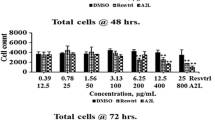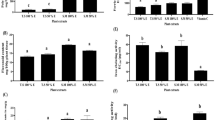Summary.
Background: Grapes and wine contain high concentrations of polyphenolic compounds. Although their cancer protective effect has been well documented, their activity as anticarcinogens should be cautiously considered since the molecular bases of action and their applicability to human cancer prevention are still unclear. Aim of the study: We studied the antioxidant/antiradical activity and the antiproliferative effect in vitro of different polyphenolic mixtures, extracted from grapes and fractionated through RP-HPLC. Methods: The polyphenolic fractions were chemically characterized and their antioxidant/antiradical activity was determined by the DPPH assay. Mouse hepatoma Hepa-1c1c7 cells were used to study the cell growth inhibition capacity of these fractions by MTT assay. Their capacity of altering cell cycle and possible induction of apoptosis was examined using FACS analysis. Results: The original polyphenolic fraction OW, which contained gallic acid (GA), (+)-catechin (Cat), (−)-epicatechin (Ec), glycosylated flavonols (F) and procyanidin oligomers was fractionated into fraction I, composed of monomers and small oligomers, and fraction II that included flavonols and procyanidin oligomers of higher molecular weight. The three polyphenolic fractions tested showed quite similar antiradical activity, although fraction I was the most potent antiradical agent (lowest ED50 value: 9 μg). Fraction II was the least potent cell growth inhibitor (highest IC50 value: 100 μg/ml) but showed the strongest effect on the cell cycle of Hepa-1c1c7, inducing apoptosis in those cells. The original fraction OW was demonstrated to have the most potent cell growth inhibition effect (lowest IC50 value: 43 μg/ml). However, it only appeared to alter cell cycle of Hepa-1c1c7 at concentrations higher than its IC50 and did not induce apoptosis in those cells. A similar effect on cell cycle and apoptosis was encountered for fraction I. Conclusions: The polyphenolic fractions tested in this study were potent antiradical agents and exerted an antiproliferative effect in mouse hepatoma Hepa-1c1c7 cells; the fraction with the highest degree of polimerization and galloylation (fraction II) had the most influence on the cell cycle and induction of apoptosis on Hepa-1c1c7.
Similar content being viewed by others
Author information
Authors and Affiliations
Additional information
Received: 6 July 2002, Accepted: 24 July 2002
Correspondence to: Dra. Marta Cascante Serratosa
Rights and permissions
About this article
Cite this article
Matito, C., Mastorakou, F., Centelles, J. et al. Antiproliferative effect of antioxidant polyphenols from grape in murine Hepa-1c1c7. Eur J Nutr 42, 43–49 (2003). https://doi.org/10.1007/s00394-003-0398-2
Issue Date:
DOI: https://doi.org/10.1007/s00394-003-0398-2




